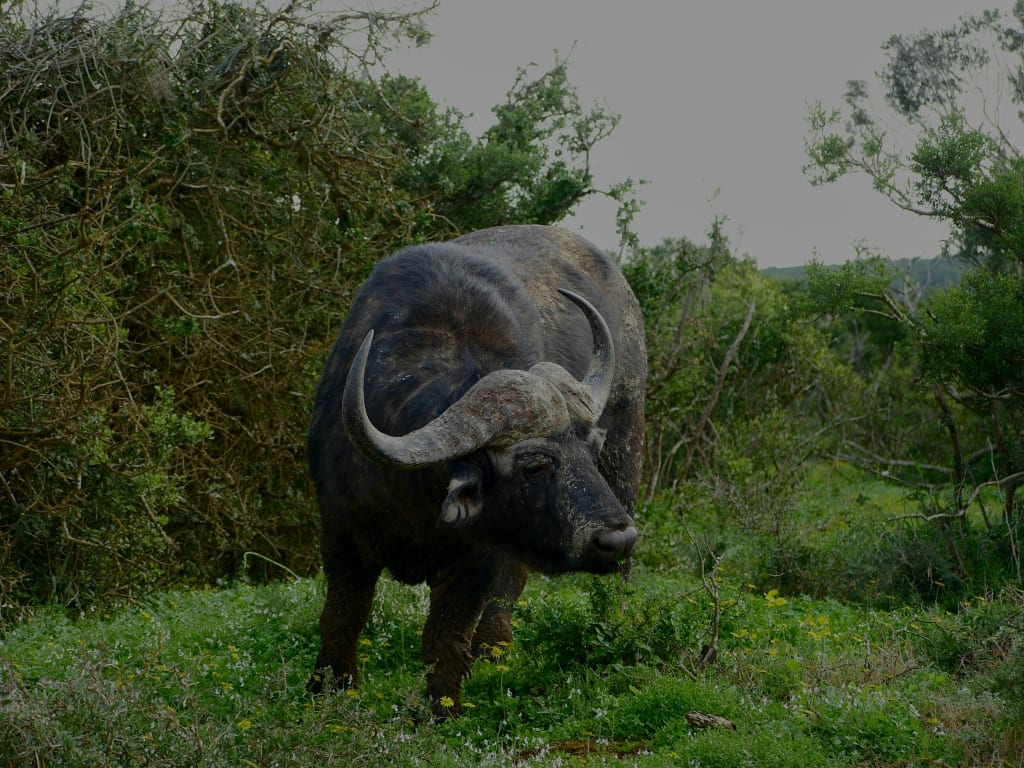The Mighty African Buffalo
Icon of the Savanna

In the vast and untamed landscapes of Africa, few animals command the respect and awe inspired by the African buffalo (Syncerus caffer). With its robust build, formidable horns, and powerful demeanor, this magnificent creature stands as an icon of the African savanna, embodying strength, resilience, and untamed wilderness.
Physical Characteristics
The African buffalo is a large and robust bovine, distinguished by its dark brown or black coat, which is sparsely covered in coarse hair. Adults typically weigh between 500 and 900 kilograms (1100 to 2000 pounds), with males being larger and more muscular than females. One of the most striking features of the African buffalo is its formidable horns, which are present in both sexes and can span up to 1.5 meters (5 feet) in length. These horns, which curve outward and then inward, serve as both a formidable weapon against predators and as a symbol of dominance within the herd.
Habitat and Range
African buffaloes are primarily found in sub-Saharan Africa, inhabiting a range of habitats including grasslands, savannas, woodlands, and forests. They are particularly well-adapted to areas with access to water, as they require regular hydration. While they are not territorial animals, they do have home ranges that they move within in search of food, water, and suitable resting sites. These home ranges can vary widely in size depending on factors such as the availability of resources and the presence of predators.
Social Structure and Behavior
African buffaloes are highly social animals, forming large herds that can consist of several hundred individuals. Within these herds, individuals form strong bonds and exhibit complex social dynamics. The herd is typically led by a dominant bull, who is responsible for guiding the group and defending it against predators. Female buffaloes, known as cows, also play an important role in the herd, forming close-knit family groups with their offspring.
One of the most fascinating aspects of African buffalo behavior is their collective defense strategy. When threatened by predators such as lions or hyenas, buffaloes will often band together to form a defensive circle, with the calves and weaker individuals protected in the center. This coordinated defense makes them a formidable opponent even for large predators, and encounters between buffaloes and lions are often dramatic and intense.
Ecological Role
As keystone herbivores, African buffaloes play a crucial role in shaping the ecosystems they inhabit. By grazing on grasses and other vegetation, they help maintain the balance of plant species and prevent the encroachment of woody vegetation into grasslands. Additionally, their dung provides important nutrients for soil fertility, benefiting a wide range of other organisms. As such, the presence of healthy buffalo populations is often indicative of a thriving and diverse ecosystem.
Conservation Status
While African buffaloes are not currently considered endangered, they face a range of threats that jeopardize their long-term survival. Habitat loss and fragmentation, primarily due to human activities such as agriculture and infrastructure development, pose significant challenges to buffalo populations. Additionally, they are susceptible to diseases such as bovine tuberculosis and foot-and-mouth disease, which can be transmitted from domestic livestock.
Efforts to conserve African buffaloes include the establishment of protected areas where they can roam freely, as well as initiatives to mitigate human-wildlife conflicts and address disease outbreaks. Public awareness and education also play a crucial role in promoting coexistence between humans and buffaloes and fostering appreciation for these magnificent creatures and the ecosystems they inhabit.
Conclusion
The African buffalo is not merely a symbol of the African wilderness; it is a keystone species that plays a vital role in maintaining the health and diversity of its habitat. With its imposing presence, complex social structure, and vital ecological role, the buffalo stands as a testament to the resilience and beauty of Africa's natural world. As we strive to conserve and protect these magnificent animals, we also uphold our commitment to preserving the rich tapestry of life that makes our planet so extraordinary.
About the Creator
Enjoyed the story? Support the Creator.
Subscribe for free to receive all their stories in your feed. You could also pledge your support or give them a one-off tip, letting them know you appreciate their work.





Comments
Nicole Jameson is not accepting comments at the moment
Want to show your support? Send them a one-off tip.